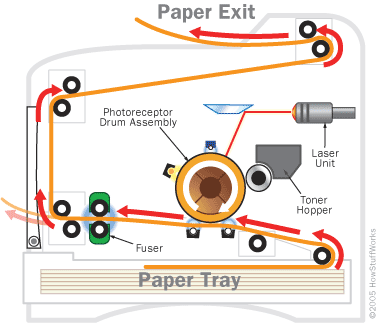How Does Toner Work
Toner and the Drum
When a laser printer starts a print job, the first thing it does is apply a positive electrical charge to the drum unit. Afterwards, the laser system ‘writes’ the page image onto the drum with a negative charge, creating an electric “virtual negative” of the image.
The Toner
The drum unit rotates, and as the image is written on it, it picks up toner, the laser printer equivalent of ink. The toner is positively charged, and so it sticks to the image that the laser drew. The paper presses against the drum, and receives the toner image.
The Fuser
When the paper first picks up the toner, the image is not set. Toner is a dry, dusty material, and it the electric charge cannot hold it strongly to the paper. In order to make the image permanent, the paper runs through the fuser, which heats it, and melts the toner onto the page. The paper exits the printer, and you have your print out.
How does a laser printer work with the toner?
The image below shows you how a laser printer works in conjuction with your toner cartridge. After you send a document to print - the paper travels through the printer, past the drum, toner and fuser unit and ends up as a printed page of text or graphics.

